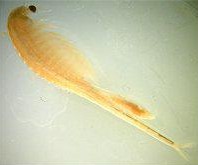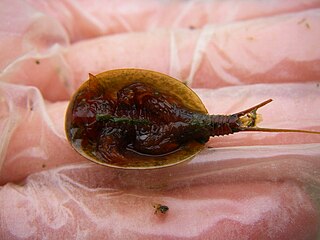
Vernal pools, also called vernal ponds or ephemeral pools, are seasonal pools of water that provide habitat for distinctive plants and animals. They are considered to be a distinctive type of wetland usually devoid of fish, and thus allow the safe development of natal amphibian and insect species unable to withstand competition or predation by fish. Certain tropical fish lineages have however adapted to this habitat specifically.

Potentilla hickmanii is an endangered perennial herb of the rose family. This rare plant species is found in a narrowly restricted range in two locations in coastal northern California, in Monterey County, and in very small colonies in San Mateo County. This small wildflower, endemic to western slopes of the outer coastal range along the Pacific Ocean coast, produces bright yellow blossoms through spring and summer.

Elaphrus viridis, the Delta green ground beetle, is a species of ground beetle restricted to a small region within Solano County, California. Its color is a metallic-green, usually with bronze spots on its elytra, though some lack these spots. The lack or reduction of circular pits on the elytra helps distinguish it from other ground beetles. Typical adults are about a quarter-inch (0.6 cm) in length.

Lasthenia conjugens, commonly known as Contra Costa goldfields, is an endangered species of wildflower endemic to a limited range within the San Francisco Bay Area of the state of California, USA. Specifically this rare species occurs in Napa, Santa Barbara, Solano, Contra Costa, Santa Clara, Monterey and Alameda Counties. This annual herb typically flowers from March through June, and its colonies grow in vernal pool habitats at elevations not exceeding 100 meters above sea level. The Jepson Manual notes that the present distribution is limited to the deltaic Sacramento Valley, principally Napa and Solano Counties, but the historic range of L. conjugens is known to be significantly wider. In any case, historically the range has included parts of the North Coast, Sacramento Valley, and San Francisco Bay Area as well as the South Coast. Alternatively and less frequently this taxon has been referred to as Baeria fremontii var. conjugens.

Trifolium amoenum, known by the common names showy Indian clover and two-fork clover, is endemic to California, and is an endangered annual herb that subsists in grassland areas of the San Francisco Bay Area and the northern California Coast Ranges.

The conservancy fairy shrimp is an endangered small crustacean in the family Branchinectidae. It ranges in size from about 1.25 centimetres (0.49 in) to 2.5 centimetres (0.98 in) long. This species is endemic to California in the United States.
The midvalley fairy shrimp, Branchinecta mesovallensis, is a small freshwater crustacean in the Branchinectidae family endemic to shallow ephemeral pools near the middle of California's Central Valley. These vernal pool ecosystems are home to other unique organisms adapted to the ephemeral nature of the water cycle in the pools in California's mediterranean climate.

Lepidurus packardi, the vernal pool tadpole shrimp, is a small, rare species of tadpole shrimp (Notostraca) found in temporary ponds of the western United States.

Neostapfia is a genus of endemic Californian bunchgrasses, in the subfamily Chloridoideae of the grass family, Poaceae. The only known species is Neostapfia colusana, with the common name Colusa grass.

Eryngium aristulatum, known by the common names California eryngo and Jepson's button celery, is a species of flowering plant in the family Apiaceae.
Eryngium constancei is a species of flowering plant in the family Apiaceae known by the common name Loch Lomond button celery, or Loch Lomond coyote thistle. It is endemic to California, where it is known from only three occurrences north of the San Francisco Bay Area. One of the populations is at the Loch Lomond Vernal Pool Ecological Reserve at Loch Lomond in Lake County. The plant appears mainly in vernal pools. It is endangered on the state and federal levels.

Tuctoria greenei is a species of grass endemic to California. Its common names include awnless spiralgrass and Greene's tuctoria. It is included by the California Native Plant Society on list 1B.1. It is also listed by the state of California as rare and by the Federal Government as endangered, having been federally listed on March 26, 1997.
Blennosperma bakeri is a rare species of flowering plant in the daisy family known by the common names Baker's stickyseed and Sonoma sunshine.

Tuctoria is a genus of three species of grass in the family Poaceae. Spiralgrass is a common name for plants in this genus. These are bunchgrass species that are found in vernal pools of central California and Baja California, Mexico. The plants are annuals that germinate under water in the spring and grow submerged for weeks. After the pools dry down, the grasses initiate a new set of foliage that lasts for one to two months until flowering and fruiting are complete.

Orcuttia is a genus of grass in the family Poaceae. Plants grow up to 20 cm (8 in) tall, usually with many stems emerging from the base of the plant, and forming a tuft. The spikelets are several-flowered, with reduced upper florets. The lemma tips have between two and five teeth.

Orcuttia californica is a rare species of grass known by the common name California Orcutt grass.

Orcuttia viscida is a rare species of grass known by the common name Sacramento Orcutt grass.
Trichostema ruygtii, with the common name Napa bluecurls, is a species of flowering plant in the mint family. It was first described to science in 2006.

Lomatium cookii is a rare species of flowering plant in the carrot family known by the common names Cook's lomatium and agate desertparsley. It is endemic to Oregon in the United States, where it grows in only two valleys. It is a federally listed endangered species.

The Phoenix Vernal Pools are located in Fair Oaks, California, a suburb of Sacramento city around 20 miles east of the city of Sacramento and north of highway 50. This land consists of seasonally inundated wetlands that form after winter rains. The climate type of Phoenix Vernal Pools is classified as Mediterranean, receiving 24 in (610 mm) of rain per year. The rainwater percolates into the soil until it reaches an impermeable hardpan that causes an elevated water table, forming the vernal pools. The Phoenix Vernal Pool ecosystem is relatively unique as is supports many species of fauna and flora endemic to vernal pools.















